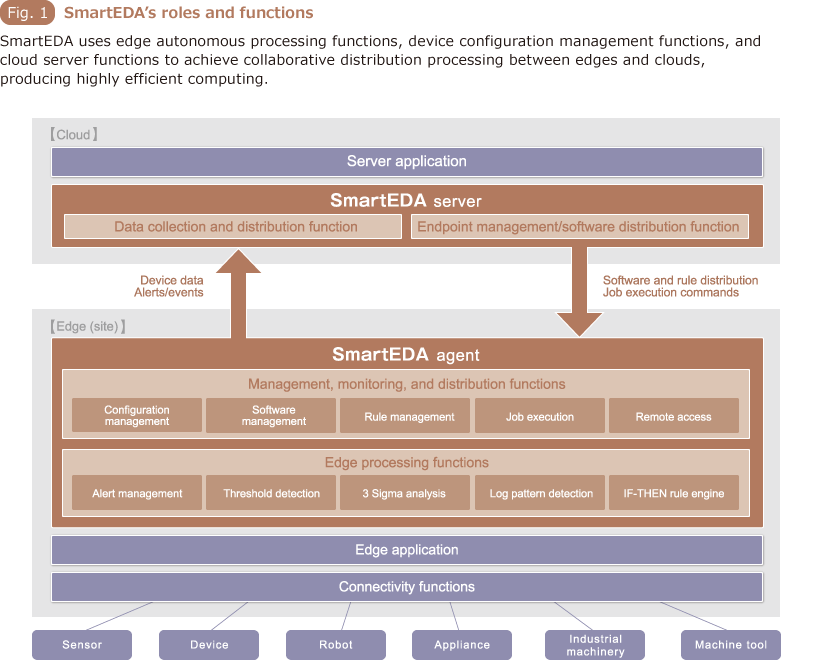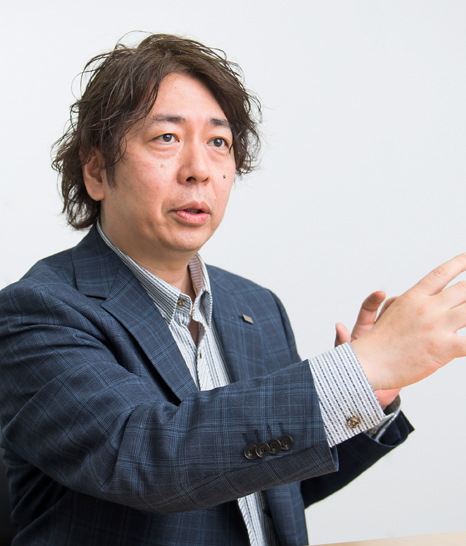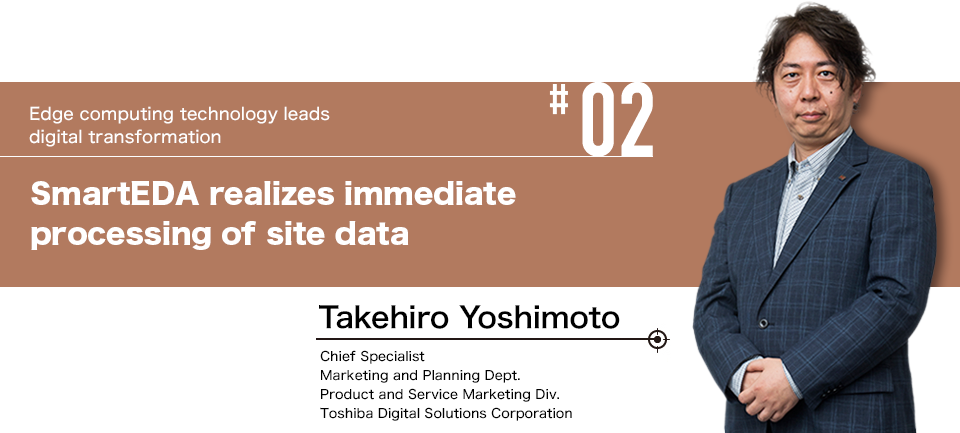Real-time processing of site data is one of the key issues involved in implementing digital transformation. It is an extremely difficult challenge to collect all diverse IoT (Internet of Things) data, which is generated at an extremely high, millisecond rate, in a data center, store it in databases, and use time-series variations to catch even the tiniest irregular values. From the perspective of heavy network load with these explosive data, as well, data processing which relies on cloud computing presents a major hurdle to realizing digital transformation. What is needed is a high-speed, efficient data processing platform which minimizes the amount of data communications between worksites and the cloud, while performing immediate on-site processing at the same time. Let's look at SmartEDA, the embodiment of the edge computing positioned as one of the core technologies in SPINEX.
A core technology of SPINEX that supports cooperation between clouds and edges
Cloud services are used in a variety of business and daily life situations. Big data collected via the IoT system is effectively analyzed using AI (Artificial Intelligence), providing users high levels of convenience and new experiences. In the past, in order to perform these processes rapidly while responding to environmental and social changes, all data has been gathered in the cloud.
However, the more service becomes sophisticated, the wider and greater varieties and volume of IoT
data becomes, such as sensor data, images, audio, and video. At the same time, the scope of acquired
data is also expanding; from factory, building, and field equipment and devices to social
infrastructure information, such as power usage conditions and transportation information, and
information regarding people's behaviors, situations, and emotions. As the amount of cloud data
expands, purely cloud-based service provision will reach at its limits. Cloud alone will not be able
to handle these explosive data.
This is why Toshiba has been at the forefront of “edge computing.” By providing devices
and gateways with intelligence, processing can be performed in the worksite, closer to end users.
Clouds and edges (sites) are linked and optimization is achieved while performing autonomous,
distributed processing. This makes it possible to perform high-speed processing of IoT data using
appropriate devices and at appropriate locations, while minimizing communications delays and the
loads placed on clouds. Performing on-site processing of data requiring real-time processing and
cloud processing of data which is accumulated before processing helps produce more effective data
utilization methods and create innovative services. It is believed that the use of edge computing
along with cloud computing keeps growing, and 40% of the data now kept on clouds will be migrated to
edges by 2020. In the future, edge computing will be expected to make major contributions to
automated driving systems and drone-based monitoring systems.
Click here to move to the top of this page.
Advanced intelligence and flexible rules
Edge computing is one of the core technologies in Toshiba's SPINEX IoT architecture. Large amounts of
data, arranged in chronological order, undergo efficient collaborative distributed processing at the
site and in the cloud. Because of the rapid reaction speeds of sites and the advanced analysis in
the cloud, edge computing is ideal solution for realizing digital transformation.
Toshiba's SmartEDA is a data collection and event processing platform for building using edge
computing technology. It is composed of SmartEDA Agents, which autonomously process data in devices
and gateways, and SmartEDA Servers, which collect data from clouds, factories, facilities, and the
like, and perform device management. Intelligent devices and servers communicate with each other,
performing different roles, to reduce the volume of communications between sites and clouds while
performing immediate processing of site data (Fig. 1).

One of SmartEDA Agent's major features is its edge intelligence. It possesses various algorithms and
determination functions to rapidly detect irregularities in data which arrives every matter of
milliseconds, and to issue alerts and perform automatic processing. For example, it performs 3 sigma
analysis, using sensor values for a specified time interval as an analysis population and
identifying not only deviating values but also gradual changes and degradation trends. Log pattern
detection finds out specified patterns in log data. An IF-THEN rule engine issues notifications and
performs automatic processing based on edge data values and combinations of values.
Event information detected on the edge is stored in the cloud and is available for analysis. With
machine learning, event acquiring accuracy, such as abnormalities, is expected to increase. On the
other hand, on the cloud side, multiple events are combined and used in compound data processing.
This makes it possible to detect chain reactions and errors caused by interference, as well as signs
of these phenomena occurring in the imminent future, and implement proactive control and
preventative maintenance.
Another of SmartEDA's features is its convenience. It allows detected events and processing rules
obtained via big data analysis in the cloud to configure in-site agents. It does not merely send
information to site devices, but is capable of configuring and changing rules tailored to site
device configurations. It can manage configuration information, such as what gateway devices are
connected to what machine tools, as well as the version numbers of the software in the machine
tools, helping to tailor rules to specific devices. Because of this function, edge computing is
suitable not only for periodic use in mass production manufacturing lines, but also in small lot,
high variety production in which products, components, and materials change dynamically.
Click here to move to the top of this page.
Wide-ranging potential of SmartEDA, from maintenance efficiency improvement to use together with location information

SmartEDA not only monitors and detects irregularities in factory device, but also possesses
innovative functions for supporting field IoT solutions. In conventional device and equipment
maintenance, when outage notifications are received it is common to not know which components need
to be replaced until on-site examination completed. The components are then ordered and engineer
visited again for its replacement. SmartEDA's remote access function makes remote maintenance easy,
reducing costs and maintenance times. Site gateway devices are logged into via the cloud and device
conditions and logs can be checked remotely. This makes it possible to determine components
replacement timing in advance.
SmartEDA also provides functions for simply and efficiently organizing and managing applications
customers use for individual operations and issues, such as information display functions linked
with wide area maps, facility floor maps, and store floor maps.
SmartEDA has potential for use in
a wide range of scenarios thanks to its real-time data processing capabilities rooted in edge
intelligence and its ability to provide advanced manageability and convenience in mobile
form.
Agents can be installed in smartphones and used in place of gateway devices to combine
information obtained from sensors with smartphone GPS (Global Positioning System) positioning
information and send it to the cloud.
For example, in the distribution field, truck locations, cargo conditions such as temperatures and
cargo volumes, and the like can be tracked and used to optimize truck allocation and reduce delivery
risks. SmartEDA has been used in pilot tests to assess cooling conditions and shock information for
fresh vegetable delivery trucks, analyze and optimize delivery, and identify delivery container
locations. By being combined with IF-THEN rule engines, it can automatically perform required
processing when necessary, based on sensor conditions and the locations of smartphone users by
processing and notification settings configured in advance.
Work is underway for vehicle-mounted
gateways, for use in vehicle IoTs using SmartEDA.
We are also considering integration SmartEDA with LPWA (Low Power Wide Area) wireless technology, which is capable of transferring data several kilometers. LPWA enables to acquire information from sensors distributed over a wide area while using extremely little power. IoT use case will be expanding tremendously by LPWA. This will further expand the usage scope of SmartEDA, which performs initial data processing, irregularity detection, and decision-making in site devices and gateway devices.
By realizing digital transformation with edge computing, nothing would make us happier than if SmartEDA were to help to creating richer industries and society.
* The corporate names, organization names, job titles and other names and titles appearing in this article are those as of July 2017.











